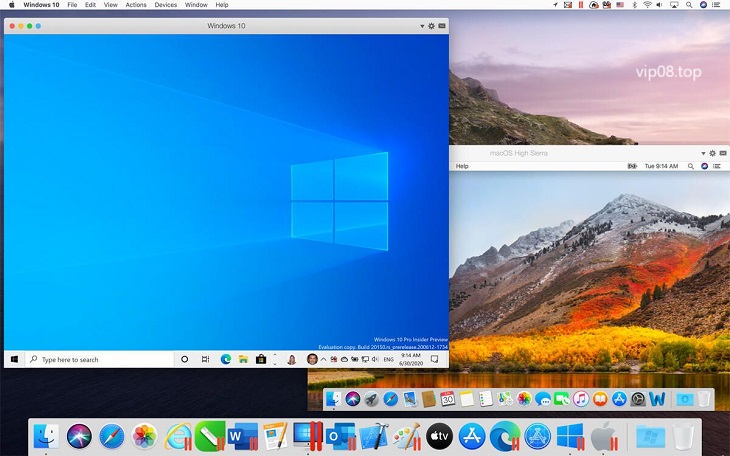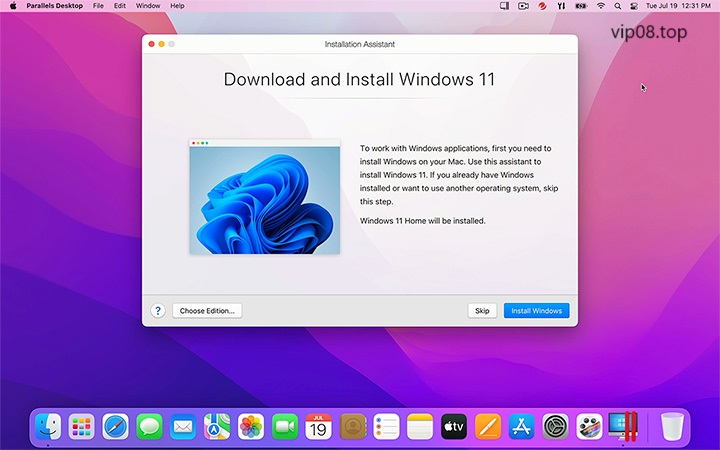Introduction

Parallels Desktop for Mac is desktop virtualization software which enables Microsoft Windows, Linux and Google Chrome operating systems and applications to run seamlessly on an Apple Mac computer. The program integrates its guest OS seamlessly into macOS so as to provide optimal performance similar to native OSes.
User can opt to run Mac and guest applications side-by-side or as full virtual desktops on Mac OS. They can open Windows apps like Internet Explorer and Media Player through Mac Finder utility; similarly they can move documents, folders or data back and forth between File Explorer on Windows PCs and Finder on mac OS with ease. Furthermore, they have full control of which OS specific applications should open based on which setting.
Parallels Desktop for Mac offers three modes to meet user needs: Coherence allows guest and Mac applications to coexist side-by-side within one window; Full Screen mode creates an entire guest desktop; Modality provides users with control to resize or customize virtual machine windows running atop macOS;
Parallels Desktop for Mac Business Edition provides IT administrators with central deployment and management features designed to simplify Windows virtual machine delivery, linking with an update server to ensure guest OS stay up-to-date, enforcing USB thumb drive device policies and restricting users from altering VM settings or creating new virtual machines. Business Edition also boasts security capabilities like restricting USB thumb drive policies while restricting users from altering or creating new virtual machines.
How Does It Work?
Parallels Desktop utilizes a technology known as hypervisor for creating and managing virtual machines. The hypervisor functions to act as a bridge between your physical hardware on the Mac with the virtual computers, which ensures an efficient and smooth operation.

Key Features
- Seamless Integration The one of the most notable aspects that comes with Parallels Desktop is flawless integration to macOS. It is possible to change between your Mac or virtual computer in a snap like they are native apps.
- Coherence Mode It allows users the ability to use Windows apps directly from your Mac desktop and eliminates the need to switch between desktops. It provides a seamless user experience.
- Speed Optimization Parallels Desktop is optimized for performance, making sure the virtual machine function effortlessly and effectively. You can assign resources such as RAM and CPU to each VM depending on the need.
- Snapshot and Back-up The program comes with an option to snapshot that lets users to create pictures of virtual devices. This feature can be useful in creating backup points and testing different configurations with no the risk of.
- Compatibility with Cross-Platforms: Parallels Desktop supports an array of operating platforms, which makes it a flexible solution to different requirements.
Running Windows on Mac
One of the most common applications for Parallels Desktop is running Windows applications on the Mac. This is particularly beneficial for those who rely on a specific Windows-only program. With Parallels it is possible to use Windows along with macOS which makes it simple to switch between both environments.
System Requirements
Before you dive deep into Parallels Desktop it is crucial to ensure that your Mac is compatible with the specifications of your system. The requirements will differ based what version of Parallels Desktop you choose to install.
How do I install Windows on my Mac using Parallels Desktop?

To install Windows on your Mac using Parallels Desktop, you can follow these general steps:
- Launch Parallels Desktop on your Mac.
- Choose one of the following scenarios that best suits your situation:
- Scenario 1: You have just installed Parallels Desktop on your Mac.
- Scenario 2: You have Parallels Desktop on your Mac, and you want to add a Windows virtual machine (VM).
- Scenario 3: You want to move Windows from a physical PC into a Parallels Desktop VM.
For detailed instructions on how to install Windows 10 in Parallels Desktop for Mac, you can refer to the official Parallels Blog. They provide step-by-step guidance for each scenario.
Can I use my Windows license on Parallels Desktop?
Yes, you are able to make use of the Windows licensing through Parallels Desktop. If you want to run Windows in your Mac with Parallels Desktop, you will require an active Windows licence key.
If you do not have an Windows licence key yet, it is possible to buy one through Microsoft Store Microsoft Store or other authorised stores.
It is important to note that the precise steps to activate your Windows license could differ based what version of Windows that you’re running as well as the edition of Parallels Desktop you have installed. It’s always best to refer to either the documentation provided by Microsoft or videos for the most up-to date instructions.
FAQs
Should I download parallel on Mac?
Downloading Parallels on Mac is optional. It’s software for running Windows alongside macOS.
Do you need Parallels to run Windows on a Mac?
Parallels helps run Windows on Mac, but it’s not the only way. You can use Boot Camp as an alternative.
Can you run Windows on a MacBook Pro using Boot Camp?
Yes, you can run Windows on a MacBook Pro using Boot Camp, which is built-in software by Apple.